On Wednesday, we woke up at the Leonardo Plaza Hotel in Tiberias. As I mentioned in my previous blog post, this hotel is situated right at the Sea of Galilee. When I woke up in the morning, I opened my window from my room on the 10th floor and walked out onto the balcony to take in the breathtaking view of the enormous Sea of Galilee. It is essentially a large lake, but it is one of Biblical proportions. I saw some boats out on the water and just pictured Jesus and his disciples fishing out there. What a vision!
I walked downstairs and took in the enormous breakfast buffet that was included as part of this hotel stay. We gathered with the group and were on the bus by 8:30am. Our first stop was to Magdala, the town where Mary of Magdala (Mary Magdalene) is from (hence the “of Magdala”). After the mother of Jesus, Mary Magdalene was the most important female in the New Testament. St. Thomas Aquinas later called her the Apostle to the Apostles. Very recently (in 2009) they found the remnants of a synagogue here in Magdala (part of the Galilee region) – the Migdala Synagogue – that dates to the time of Christ. It is with almost 100% certainty that Jesus taught in this temple, with the same structure here completely preserved.
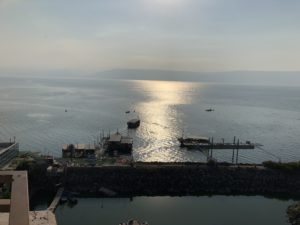 We visited the remnants of this synagogue. Everything that we saw was here at the time of Christ. These are the floors he walked on. In Matthew 23:4, it says that “He went around all of Galiee, teaching in their synagogues, proclaiming the gospel of the kingdom, and curing every disease and illness among the people.” As we read these words while our group visited the site, I was just blown away. I’m standing in the same place Jesus taught.
We visited the remnants of this synagogue. Everything that we saw was here at the time of Christ. These are the floors he walked on. In Matthew 23:4, it says that “He went around all of Galiee, teaching in their synagogues, proclaiming the gospel of the kingdom, and curing every disease and illness among the people.” As we read these words while our group visited the site, I was just blown away. I’m standing in the same place Jesus taught.
After our time here, we boarded back on our chartered bus and went north. Our tour guide Johav told us to look to the fields, valleys, and hills to the west. That’s the direction of Nazareth. That’s the direction Jesus traveled from – he walked in those days – as he made his way over to those synagogues in Galilee. He saw this same landscape, the same skies, that we were seeing today. He must have sweated, because it’s a pretty warm day here in August.
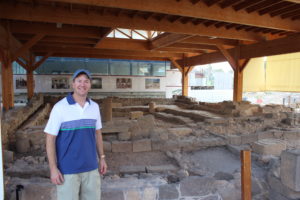 As we traversed the roads, we passed by the Mount of Beatitudes, where we would come back to later. But first we picked up a top scholar named Dr. Elliot Chodoff. He is a Jew from New York, who has lived in Israel since the early 1980s, where he has taught at a university here. He is also a political and military analyst. We traveled through the Golan Heights, which is an area that Israel captured from Syria during the Six-Day War in 1967 – one that Syria and other Arab countries started with Israel. It’s a strategic area that Israel won’t be giving back anytime soon, because it is a high point that would give the other side the ability to attack civilians in Israel from a mountain top.
As we traversed the roads, we passed by the Mount of Beatitudes, where we would come back to later. But first we picked up a top scholar named Dr. Elliot Chodoff. He is a Jew from New York, who has lived in Israel since the early 1980s, where he has taught at a university here. He is also a political and military analyst. We traveled through the Golan Heights, which is an area that Israel captured from Syria during the Six-Day War in 1967 – one that Syria and other Arab countries started with Israel. It’s a strategic area that Israel won’t be giving back anytime soon, because it is a high point that would give the other side the ability to attack civilians in Israel from a mountain top.
Our bus pulled up to a strategic viewpoint where we could see the border with Syria. But as Elliot told us, “geo-strategically we’re in an area that doesn’t exist.” In fact, when we opened up our iPhone and Google maps, there are no settled borders in this area. Unfortunately, over in Syria, there is a civil war, where more than 800,000 people have been killed in the last decade. During our hour or so stop here, where there was a nice cool breeze and some shady spots under some trees, we listened to Elliot recount so much history and the current situation. About half way through the lesson for the day, a very powerful round of artillery was heard in the distance. Some of us jumped back. Whoa.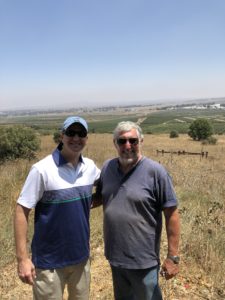
“If you heard that, you’re still alive,” Elliot said, somewhat lightly, He told us that round was probably about 10-15 miles away and was a 152mm Russian field gun, which is much like a cannon and sometimes situated on a tank.
I learned so much in this hour or so with Elliot. First, we learned that most of what we see, hear, and read from the American and Western media is just not reality. He said these are not wars of religion. Rather, these are ethnic wars. With that said, in this part of the world your religion and ethnicity is closely linked. Israel and the Middle East are a land bridge between the continents of Asia, Africa, and Europe, and between oceans, the Indian Ocean and the Atlantic Ocean, which is accessible through the Mediterranean. The Middle East and the Arab world were created about a hundred years ago. “Arabs are not all Muslims and not all Muslims are Arabs,” he told us. It’s a regional distinction, not a religious one. The Middle East was created by the British and the French around the time of World War 1. We’re still living with the mess – but he also made the point, just because you’ve been handed a mess doesn’t mean you don’t have some responsibility in dealing with it.
He also said that as much as we’d like to think American engagement here is strong, he said America has actually been disengaging from the Middle East, even since the administration of George W. Bush. America is no longer dependent on oil from here, but reminded us that oil has only been important for the past one hundred years. The Middle East has been important for about 4,000 years. He hopes America realizes that oil isn’t the only important reason to be engaged here.
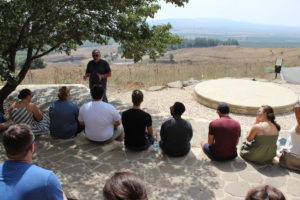 The three powers who are now filling the vacuum and having the most influence here are the Russians, the Turks, and the Iranians. He gave us all the reasons for that. But he spent the most time on the Russians and on Putin. He said what Putin did in Crimea was to capture access to the Black Sea. And the reason Russia is helping Syria build up its ports, is so that Syria will give the Russians access to the Mediterranean – a strategic point that then connects them to the Atlantic.
The three powers who are now filling the vacuum and having the most influence here are the Russians, the Turks, and the Iranians. He gave us all the reasons for that. But he spent the most time on the Russians and on Putin. He said what Putin did in Crimea was to capture access to the Black Sea. And the reason Russia is helping Syria build up its ports, is so that Syria will give the Russians access to the Mediterranean – a strategic point that then connects them to the Atlantic.
The Syrian Civil War has also created an interesting dynamic. It has pushed many terrorist organizations within Syria close to the border of Israel. Elliot told us the area we were standing at – the parts of Syria we see (and a little beyond it0 from this very spot in Israel is the most densely packed area of terrorist organizations in the world. Hezbollah, Al Qaeda, ISIS, and about 50 other terrorist organizations are located in this region. But they are in a demilitarized zone that Israel keeps a close eye one. They sort of have a truce with Israel because Israel has sent a strong message that if they even try to harm any Israeli civilians there would be immediate and overwhelming response. While we were there, we also saw members of the Israeli and U.S. military getting their own briefings along the border, along with some U.N. security patrols. Elliot pointed out the U.N. security base below and said to us that the only thing the U.N. is useful for is observing.
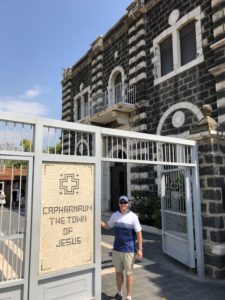 What side should a liberal Western democracy like the U.S. take in the Syrian Civil War? Elliot said in this region of the world, we have no good decisions. In fact, he said the only real decisions at all are between bad decisions and worse decisions. Everyone can decide between a clear good and bad decision. And if you have two good decisions, those are pretty easy to deal with too. But the worse thing is when you have a only a choice between a bad decision or a worse decision, and that’s often what they face in this region of the world. But he made it clear that we can’t confuse “bad” with “wrong.” Sometimes a bad decision can still be the right (or at least not the wrong) decision given the dynamic.
What side should a liberal Western democracy like the U.S. take in the Syrian Civil War? Elliot said in this region of the world, we have no good decisions. In fact, he said the only real decisions at all are between bad decisions and worse decisions. Everyone can decide between a clear good and bad decision. And if you have two good decisions, those are pretty easy to deal with too. But the worse thing is when you have a only a choice between a bad decision or a worse decision, and that’s often what they face in this region of the world. But he made it clear that we can’t confuse “bad” with “wrong.” Sometimes a bad decision can still be the right (or at least not the wrong) decision given the dynamic.
We were standing 35 miles from the Syrian capital of Damascus. Unreal how close we are to one of the most war-ravaged regions in the world. When we heard that artillery fire, this was no longer a war I was hearing about in the news. It was a real, hot war right in front of us. Elliot told us every time he’s here he sees or hears something. Today was actually a relatively quiet day. But he assured us the ground we were standing on was very safe. He also told us the Israeli army had hundreds of special op forces in the land area all around us that we could not see.
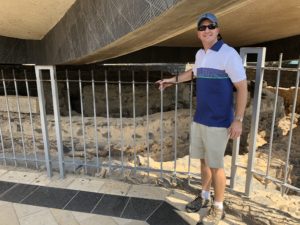 After our security briefing, we were transported about 15 minutes to the north, in the direction of Lebanon, to a Druze Village. The Druze people separated from Islam about one thousand years ago. They are located in Israel, Lebanon, and Syria. They each have their own loyalties to the respective countries they are living in. We stopped into a great lunch location in the Druze Village here. Most of the places we are eating at are serving our group many different small dishes in a family-style serving. So we are getting a great sampling. Today for lunch, some of the highlights included perhaps the best falafel and humus I’ve ever tasted. And then they kept bringing more food, including beef, chicken, and lamb skewers. I was so full I couldn’t eat any more.
After our security briefing, we were transported about 15 minutes to the north, in the direction of Lebanon, to a Druze Village. The Druze people separated from Islam about one thousand years ago. They are located in Israel, Lebanon, and Syria. They each have their own loyalties to the respective countries they are living in. We stopped into a great lunch location in the Druze Village here. Most of the places we are eating at are serving our group many different small dishes in a family-style serving. So we are getting a great sampling. Today for lunch, some of the highlights included perhaps the best falafel and humus I’ve ever tasted. And then they kept bringing more food, including beef, chicken, and lamb skewers. I was so full I couldn’t eat any more.
I should also mention, we were very close to Mount Hermon, which is where the Isaeli-Lebanon border is. Our guides told us this is the mountain where it is believed the Transfiguration of Jesus happened. This mountain was quite large (9,200 feet elevation). My first thought was: wow, Jesus really made those Apostles hike! Then again, it was quite a miracle. I’d hike to see that!
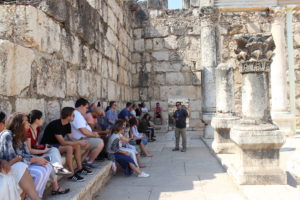 As the story is told in Matthew chapter 17, “And after six days Jesus taketh Peter, James, and John his brother, and bringeth them up into a high mountain apart, And was transfigured before them: and his face did shine as the sun, and his raiment was white as the light. And, behold, there appeared unto them Moses and Elijah talking with him.” This is also where they heard the voice of the Father telling them, “This is my beloved Son, in whom I am well pleased; hear ye him. And when the disciples heard it, they fell on their face, and were sore afraid. And Jesus came and touched them, and said, Arise, and be not afraid.” This happened right up there.
As the story is told in Matthew chapter 17, “And after six days Jesus taketh Peter, James, and John his brother, and bringeth them up into a high mountain apart, And was transfigured before them: and his face did shine as the sun, and his raiment was white as the light. And, behold, there appeared unto them Moses and Elijah talking with him.” This is also where they heard the voice of the Father telling them, “This is my beloved Son, in whom I am well pleased; hear ye him. And when the disciples heard it, they fell on their face, and were sore afraid. And Jesus came and touched them, and said, Arise, and be not afraid.” This happened right up there.
We boarded the bus again and took a drive down to Capernaum – this is the city that Simon Peter lived in. It was a fishing village, right along the Sea of Galilee. The sign upon entering the city said “Capernaum, the town of Jesus.” The reason it says that is because Jesus spent so much time here. He often stayed with Peter. There are a few main archeological sites here. One is Peter’s house. There is a church built above that some say looks like a “space ship” hovering above it, because of the way they allow you to see the archeological site of Peter’s home below it. Once you go into the church, there is a glass floor in front of the altar that you can see. This entire sight is run by the Catholic Church, so this is a Catholic Church.
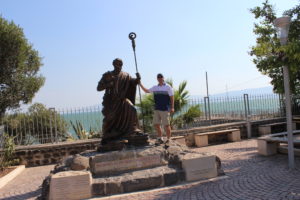 As I looked down into Peter’s home, I thought about the fact that Jesus was right here. He worked here, he slept here. He performed miracles here. Then, I looked up behind the altar and saw the Eucharist on display for adoration. Jesus is still here.
As I looked down into Peter’s home, I thought about the fact that Jesus was right here. He worked here, he slept here. He performed miracles here. Then, I looked up behind the altar and saw the Eucharist on display for adoration. Jesus is still here.
Across the way, there is also the ruins of a synagogue. The ruins date to the Fourth Century AD but they believe that there is another synagogue from Jesus’ time below it. As our group gathered in the synagogue here, Raj read us from the scriptures.
In Mark chapter 1, it is said that “then they came to Capernaum, and on the Sabbath he entered the synagogue and taught. The people were astonished at his teaching, for he taught them as having authority and not as their scribes. In their synagogue was a man with an unclean spirit.” Jesus brought the demon out of this man. “The unclean spirit convulsed him and with a loud cry came out of him. All were amazed and asked one another, ‘What is this? A new teaching authority. He commands even the unclean spirits and they obey him.” This happened right here in the synagogue in Capernaum, where we were at this moment.
Jesus then left Capernaum to teach in other nearby synagogues and heal others.
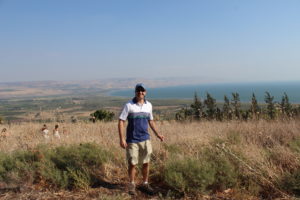 In Mark, chapter 2, it is said that “When Jesus returned to Capernaum after some days, it became known that he was at home. Many gathered together so that there was no longer room for them, not even around the door, and he preached the word to them. They came bringing to him a paralytic carried by four men. Unable to get near Jesus because of the crowd, they opened up the roof above him. After they had broken through, they let down the mat on which the paralytic was lying. When Jesus saw their faith, he said to the paralytic, “Child, your sins are now forgiven.”
In Mark, chapter 2, it is said that “When Jesus returned to Capernaum after some days, it became known that he was at home. Many gathered together so that there was no longer room for them, not even around the door, and he preached the word to them. They came bringing to him a paralytic carried by four men. Unable to get near Jesus because of the crowd, they opened up the roof above him. After they had broken through, they let down the mat on which the paralytic was lying. When Jesus saw their faith, he said to the paralytic, “Child, your sins are now forgiven.”
We walked out of the synagogue and took in the rest of this site by the Sea of Galilee. We walked down to an area filled with rocks along the shore. You are permitted to take a few small ones, and I did. I also took in the beautiful statue of St. Peter that was placed here only in the last 20 years. It reminds us of Jesus’ words to Peter, when he told him, “You are the rock and on this foundation I will build my church.” Kind of neat to see there is actually a church upon the very rocks of Peter’s home. Before leaving this area, I tried to just take in the fact that Jesus, Peter, and the other disciples were here in this village. These are the waters they saw; the mountains, the sky. It all is the same topography they saw.
This is where they launched their fishing boats, where Jesus taught them to be fishers of men. It’s where he went out into the waters with them and where he performed the miracles which filled their boat with more fish than they could handle. It’s where Jesus walked on the water. Just amazing.
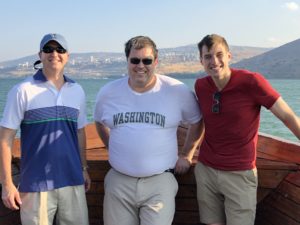 We left this site and headed not too far away to the Mount of the Beatitudes. This is a large hillside where Jesus took his apostles to preach to them a new teaching in what has become known as the most Christian of all teachings, the Sermon on the Mount.
We left this site and headed not too far away to the Mount of the Beatitudes. This is a large hillside where Jesus took his apostles to preach to them a new teaching in what has become known as the most Christian of all teachings, the Sermon on the Mount.
As our guides reminded us, they said take a look around the physical attributes of this place. Look at the hillsides and the other mountains within view. Look at the mustard seeds in the field we were standing in.
A pastor is with us on this trip, Deamon Scapin of Triumph Church DC. He took the opportunity of our standing there to read to us the words of Jesus from the Sermon on the Mount. When he read the Sermon on the Mount at this spot, the sermon made so much more sense to me now. A city on the mountain, the salt of the earth, the mustard seed. Jesus was using the physical setting in front of him and around him to teach the common men and women surrounding him. He was making it real for them and today He made it real for me as well, on this beautiful hillside overlooking the Sea of Galilee. I took a few mustard seeds from the plants in front of us as I looked across to see a visible city on a mountain.
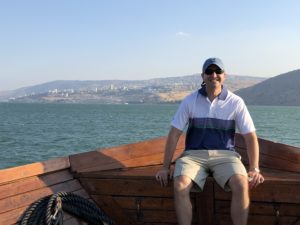 This day was complete – but it also felt like it was completing my faith journey. Walking in the footsteps of Jesus, visiting synagogues he taught in, the village he lived in, the sea he fished in, and the countryside where he delivered the Sermon on the Mount. The Gospel was becoming more real than anytime in my life. It really hit me that historical Jesus lived right here. He came into the physical world and lived among us. He breathed this air, saw this view, and sweated in this heat.
This day was complete – but it also felt like it was completing my faith journey. Walking in the footsteps of Jesus, visiting synagogues he taught in, the village he lived in, the sea he fished in, and the countryside where he delivered the Sermon on the Mount. The Gospel was becoming more real than anytime in my life. It really hit me that historical Jesus lived right here. He came into the physical world and lived among us. He breathed this air, saw this view, and sweated in this heat.
He also sailed in the sea below and that’s something we were doing next. We took the bus down to the water and departed with all of our things and boarded a boat and sailed along the sea for about an hour, until we reached Tiberias. Jesus and his Apostles actually never came into Tiberias, which was a heavily Roman-occupied area very hostile to Jews at the time. But we came in today and had dinner at a restaurant overlooking the sea, as the sun was setting. Once again, a family-style Mediterranean meal that was just delicious. And getting to know our fellow travelers better felt like we were certainly adding members to our own family.
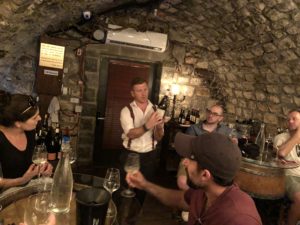 We ended the evening with an optional wine tasting (that almost all of us opted for) at a nearby Scottish restaurant. We tasted six different Israeli wines that were delicious. The room we were in was a lower level wine cellar. It was a fun way to end a spectacular day in Galilee. I couldn’t leave without purchasing some Cana wine (which was not one we tasted). But considering that Jesus’ first miracle was at the Wedding of Cana, I thought I’d pick up some Cana wine. Perhaps I’ll open it on someone’s special wedding day. For now, I just went back to the hotel and felt like a whole new chapter in my life was opening up. Jesus took us through Galilee and took us back through the scriptures to make them come even more fully alive.
We ended the evening with an optional wine tasting (that almost all of us opted for) at a nearby Scottish restaurant. We tasted six different Israeli wines that were delicious. The room we were in was a lower level wine cellar. It was a fun way to end a spectacular day in Galilee. I couldn’t leave without purchasing some Cana wine (which was not one we tasted). But considering that Jesus’ first miracle was at the Wedding of Cana, I thought I’d pick up some Cana wine. Perhaps I’ll open it on someone’s special wedding day. For now, I just went back to the hotel and felt like a whole new chapter in my life was opening up. Jesus took us through Galilee and took us back through the scriptures to make them come even more fully alive.

Wow Cisco, I didn’t realize you were doing this I’ve been watching your post regularly and I guess I didn’t click on this sooner. This is awesome! You summarized it really well. The fact is the American Media presents one side. They never present the New Jersey size state that has enemies at every border. Eternal vigilance is far more hyper present and Israel than anywhere else in the world. They can’t afford the fail one time
What hotel are you at in Jerusalem